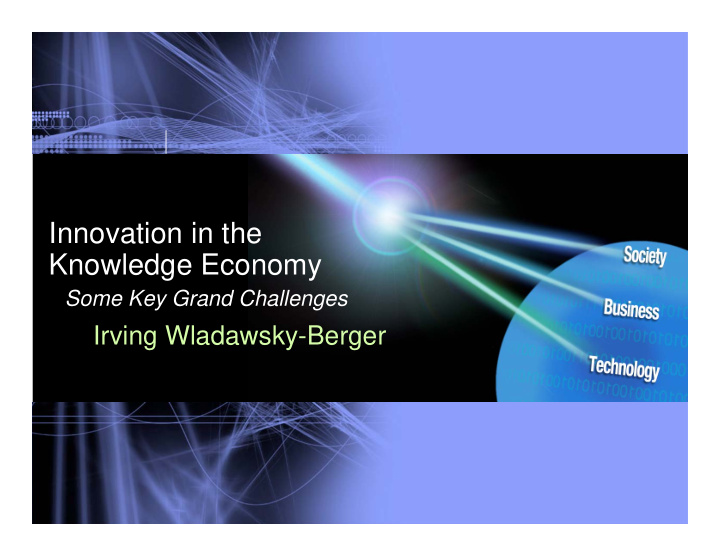



Innovation in the Knowledge Economy Some Key Grand Challenges Irving Wladawsky-Berger
Focus on Innovation “We will fight our battles not on the low road to commoditization, but on the high road of innovation.” - Howard Stringer, Chairman and CEO, Sony Corporation “Constant reinvention is the central necessity at GE... We're all just a moment away from commodity hell.” - Jeffrey Immelt, Chairman and CEO, GE “We’ve committed ourselves to a business model that relies on continual innovation” - Sam Palmisano, IBM CEO “Economic competition in the flat world will be more equal and more intense... the most important attribute you can have is creative imagination.” - Thomas Friedman 2
What Is Innovation? � Significant value created for society or business: -Creates new industries and markets -Spurs productivity and economic growth -Fuels wealth creation and profits -Generates high-value, higher-paying jobs -Raises standard of living � Innovation has to be useful as well as unique � Requires looking beyond today’s problems But why is this so important now? 3
Why is Innovation such a business imperative? Our environment is constantly changing - Technologies: Internet, IT, bio-informatics, . . . - Market conditions: competition, commoditization . . . - Socio-economic: globalization, trade barriers . . . 4
Why is Innovation such a business imperative? Our environment is constantly changing - Technologies: Internet, IT, bio-informatics. . . - Market conditions: competition, commoditization . . . - Socio-economic: globalization, trade barriers . . . Innovation is indispensable to - adapt to changes - go after new opportunities - ward off competitors - preserve leadership position 5
Accelerating Advances in Technology Source: Kurzweil 1999 – Moravec 1998 6
Accelerating Advances in Technology Driving Costs Steadily Downward Source: Kurzweil 1999 – Moravec 1998 7
The Internet: Industrial Knowledge Economy 8
Evolution of Systems � Global, integrated � Market facing, services oriented � Complex, unpredictable 9
Evolution of IT Systems 10
Evolution of IT Systems 1960s, ’70s and Early ’80s Computers, Storage, Data Center Printers, Network, . . . 11
Evolution of IT Systems 1980s and Early ’90s Data Center, Business Unit, IT infrastructure Departments, WANs, LANs . . . Data Center Computers, Storage, Printers, Network, 12
Evolution of IT Systems Mid ’90s to Present “End-to-End” Enterprise IT Infrastructure, Applications, Data, . . . Data Center, Business Unit, IT Infrastructure Department, WANs, LANs . . . Data Center Computers Storage, Printers, Network, 13
Evolution of IT Systems Into the Future . . . Industry Eco-Systems People, Global Digital Economy Processes, Marketplace Solutions Information “End-to-End” Enterprise IT Infrastructure, Applications, Data, . . . Data Center, Business Unit, IT Infrastructure Department, WANs, LANs . . . Data Center Computers, Storage, Printers, Network, 14
Evolution of Marketplace Systems Business Applications Products Technology 15
Market Facing Systems Back Office Systems 16
People and Services Machines and Products 17
Evolution of Emergent Systems: Accelerating Change Time / Complexity 18
Global, Integrated, Rapidly Changing Digital Economy Systems of Coupled Systems Systemic, Emergent Risks 19
Some Key System Grand Challenges � Cloud Computing � Global Integrated Enterprises � Virtual Worlds 20
Cloud Metaphor � Massive Scalability, Quality of Experience 10X - 100X over the next decade 25% - 55% CGR for selected workloads Business and Real-time Information Consumer Services Web N.0 People, Devices, Sensors 21
Business and Consumer Services 22
Real-time Information 23
Devices, Sensors, etc 24
Continuing Web evolution Level of Interaction Visual, Immersive Web Experience, Participate and Co-Create Web 2.0 Share and Collaborate Early Web Access and Find Time 25
The Industrial Revolution 26
Evolution of Manufacturing 27
Leadership in Manufacturing Toyota Production System � Supply chain � Just-in-time production � Continuous improvement 28
The emergence of Cloud-based services delivery data centers The “industrialization” of the data center 29
IT infrastructure growth Spending Installed Base (US$B) (M Units) $300 50 45 Power and cooling costs $250 40 Server mgmt and admin costs 35 New server spending $200 30 $150 25 20 $100 15 10 $50 5 $0 0 6 7 8 9 0 1 2 3 4 5 6 7 8 9 0 9 9 9 9 0 0 0 0 0 0 0 0 0 0 1 9 9 9 9 0 0 0 0 0 0 0 0 0 0 0 1 1 1 1 2 2 2 2 2 2 2 2 2 2 2 Source: IDC, Virtualization 2.0: The Next Phase in 30 Customer Adoption, Doc #204904, Dec 2006
IT energy crisis � During the next 5 years, most datacenters will spend as much on energy as they do on hardware Data center watts/sq. ft. 300 200 Low High 100 0 2000 or earlier Current By 2011 Doesn’t include energy needed to remove heat… can increase overall power requirements by 80% to 120% Source: Gartner, “U.S. Data Centers: The Calm Before 31 the Storm,” ID #G00151687, September 25, 2007
The IT Complexity Crisis Classic Complex Data Center 32
Data Center “Ensemble” Approach To IT Simplification 33
Virtualized, Federated Ensembles – SOA/Grid Protocols SAP application service Hybrid service Mainframe service Database service Storage backup, archive… service WebSphere service File system service x86 service Virtual Client service DMZ appliance service Unix service Consolidation service 34
What does it take to be world-class in services delivery? Flexible, Adaptable Architectural Frameworks Security, Identity Mgmt Virtualization Integration Efficiency Systems Management 35
Some Key System Grand Challenges � Cloud Computing � Globally Integrated Enterprises � Virtual Worlds 36
Globally Integrated Business and Organizational Systems Employees Customers Suppliers Processes Information People Infrastructure 37
Recommend
More recommend